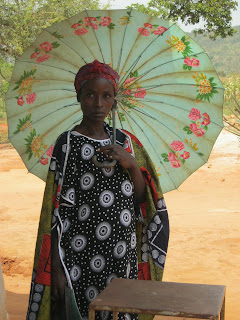

In the Kibengo Health clinic II, there is a make-shift in-patient unit for patients who need short-term hospitalization and who are not sick enough to be referred to other higher level health care centers. There are four beds in the unit but it is not uncommon to have two to three small children sharing the same bed when it becomes overwhelmingly crowded. Most of the patients are being treated for malaria as they have a higher burden of the parasites and are a lot sicker. Intravenous quinine is the treatment of choice here and their fevers are kept down with anti-pyretics and sponging. Parents are responsible for the sponging and making sure that the kids do not pull out their IVs. The caretakers take care of each other’s children and frequently share a meal on the floor of the unit. The meal is often beans, matoki mashed banana), ododo (cooked green vegetables), and occasionally some meat.



We make rounds at the beginning and end of the day. When we leave the clinic the medical officers are on-call at nights to check on them. At the end of the day the patients are usually just starting their treatment and oftentimes are quite cranky especially the children. However rounds in the morning show a complete change in the patients overnight. Most are eating and drinking and raring to go. What a difference a day of intravenous treatment with quinine and IV fluids.



Malaria continues to be rampant; we were told that in the last two months it rivals respiratory infections in incidence. It does not discriminate and affects the young, the elderly, pregnant and non-pregnant women. The symptoms of malaria are so varied that any child with vomiting and abdominal pain especially when there is a fever warrants a malaria test. This week we are low on adult coartem and have to use oral quinine instead. Also we are low on rapid malaria test kits and have to use them with care. The lab was overwhelmed with so many requests for malaria testing that we the clinicians are now doing our own tests in our exam room. The down side is that children waiting outside begin to hear crying coming from our room and they become fearful when they approach us and some of them even start crying before they are being seen. Here is a 3-year-old child who came in vomiting and had a fever. She was so stoic I did not hear a whimper from her when Joshua pricked her or perhaps she was too sick to cry. And this is a elegant woman with malaria in her seven-month of pregnancy and cannot hold down anything for 2 days. She is being admitted in the maternity ward.


At the end of the day last week a youngster had a bout of seizure, he had malaria and was not having a high fever at the time of the seizure. Very likely the malaria parasites had invaded his brain and what we say in medical jargon is he had cerebral malaria. He was transferred to a hospital for treatment.

In my training as an infectious disease specialist, we read about such tropical diseases as malaria and cholera and although I have seen cases of malaria in the US mainly from returning travelers from the third world; I have never seen so many cases of cholera and malaria until I volunteered with MTI in Haiti in its cholera outbreak and now in the Nakivale Refugee Settlement. It has been quite a humbling learning experience for me, indeed.

No comments:
Post a Comment